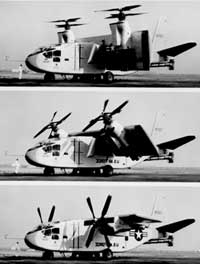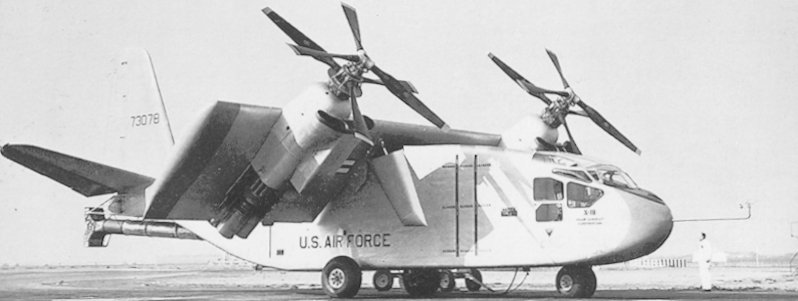|
Kaman K-16B
The Kaman K-16B was an experimental vertical-takeoff-and-landing aircraft that was constructed by Kaman Aircraft for the United States Navy in 1959 to evaluate the tiltwing concept. Converted from a Grumman Goose amphibian, the K-16B underwent extensive wind tunnel and tethered testing, but was not flown before the project was terminated in 1962. Design and development During the late 1950s, there was extensive interest in the vertical takeoff and landing concept for aircraft, with multiple experimental types ordered to develop the technology for potential service. The United States Navy contracted with Kaman Aircraft of Bloomfield, Connecticut to build a testbed based on the company's 'rotorprop' concept for tiltwing aircraft,Swanborough 1964, p.50. using a Grumman JRF-5 Goose amphibian and other existing parts to reduce the cost and time necessary.''Jane's'' 1959–1960, p.331. The fuselage and tail of the Goose were mated to a new tilting wing and engine configuration; the ... [...More Info...] [...Related Items...] OR: [Wikipedia] [Google] [Baidu] |
WikiProject Aircraft
A WikiProject, or Wikiproject, is a Wikimedia movement affinity group for contributors with shared goals. WikiProjects are prevalent within the largest wiki, Wikipedia, and exist to varying degrees within sister projects such as Wiktionary, Wikiquote, Wikidata, and Wikisource. They also exist in different languages, and translation of articles is a form of their collaboration. During the COVID-19 pandemic, CBS News noted the role of Wikipedia's WikiProject Medicine in maintaining the accuracy of articles related to the disease. Another WikiProject that has drawn attention is WikiProject Women Scientists, which was profiled by '' Smithsonian'' for its efforts to improve coverage of women scientists which the profile noted had "helped increase the number of female scientists on Wikipedia from around 1,600 to over 5,000". On Wikipedia Some Wikipedia WikiProjects are substantial enough to engage in cooperative activities with outside organizations relevant to the field at issue. For e ... [...More Info...] [...Related Items...] OR: [Wikipedia] [Google] [Baidu] |
General Electric T58
The General Electric T58 is an American turboshaft engine developed for helicopter use. First run in 1955, it remained in production until 1984, by which time some 6,300 units had been built. On July 1, 1959, it became the first turbine engine to gain FAA certification for civil helicopter use. The engine was license-built and further developed by de Havilland in the UK as the Gnome, in the West Germany by Klöckner-Humboldt-Deutz, and also manufactured by Alfa Romeo and the IHI Corporation. Design and development Development commenced with a 1953 US Navy requirement for a helicopter turboshaft to weigh under 400 lb (180 kg) while delivering 800 hp (600 kW). The engine General Electric eventually built weighed only 250 lb (110 kg) and delivered 1,050 hp (780 kW) and was soon ordered into production. First flight was on a modified Sikorsky HSS-1 in 1957, and civil certification for the CT58-100 variant was obtained two years later. A number ... [...More Info...] [...Related Items...] OR: [Wikipedia] [Google] [Baidu] |
High-wing Aircraft
A monoplane is a fixed-wing aircraft configuration with a single mainplane, in contrast to a biplane or other types of multiplane (aeronautics), multiplanes, which have multiple planes. A monoplane has inherently the highest efficiency and lowest drag of any wing configuration and is the simplest to build. However, during the early years of flight, these advantages were offset by its greater weight and lower manoeuvrability, making it relatively rare until the 1930s. Since then, the monoplane has been the most common form for a fixed-wing aircraft. Characteristics Support and weight The inherent efficiency of the monoplane is best achieved in the cantilever wing, which carries all structural forces internally. However, to fly at practical speeds the wing must be made thin, which requires a heavy structure to make it strong and stiff enough. External Bracing (aeronautics), bracing can be used to improve structural efficiency, reducing weight and cost. For a wing of a given size, ... [...More Info...] [...Related Items...] OR: [Wikipedia] [Google] [Baidu] |
Tiltwing Aircraft
A tiltwing aircraft features a wing that is horizontal for conventional forward flight and rotates up for vertical takeoff and landing. It is similar to the tiltrotor design where only the propeller and engine rotate. Tiltwing aircraft are typically fully capable of VTOL operations.Markman, Steve and Bill Holder. "Tilt-Wing VTOL Systems". ''Straight Up: A History of Vertical Flight''. Schiffer Publishing, 2000. . The tiltwing design offers certain advantages in vertical flight relative to a tiltrotor. Because the slipstream from the rotor strikes the wing on its smallest dimension, the tiltwing is able to apply more of its engine power to lifting the aircraft. For comparison, the V-22 Osprey tiltrotor loses about 10% of its thrust to interference from the wings. Another advantage of tiltwing aircraft is the ease of transition between VTOL and horizontal flight modes. A tiltrotor must first fly forwards like a helicopter, building airspeed until wing lift is sufficient to all ... [...More Info...] [...Related Items...] OR: [Wikipedia] [Google] [Baidu] |
1950s United States Experimental Aircraft
Year 195 ( CXCV) was a common year starting on Wednesday (link will display the full calendar) of the Julian calendar. At the time, it was known as the Year of the Consulship of Scrapula and Clemens (or, less frequently, year 948 ''Ab urbe condita''). The denomination 195 for this year has been used since the early medieval period, when the Anno Domini calendar era became the prevalent method in Europe for naming years. Events By place Roman Empire * Emperor Septimius Severus has the Roman Senate deify the previous emperor Commodus, in an attempt to gain favor with the family of Marcus Aurelius. * King Vologases V and other eastern princes support the claims of Pescennius Niger. The Roman province of Mesopotamia rises in revolt with Parthian support. Severus marches to Mesopotamia to battle the Parthians. * The Roman province of Syria is divided and the role of Antioch is diminished. The Romans annexed the Syrian cities of Edessa and Nisibis. Severus re-establish his head ... [...More Info...] [...Related Items...] OR: [Wikipedia] [Google] [Baidu] |
Kaman Aircraft
Kaman Corporation is an American aerospace company, with headquarters in Bloomfield, Connecticut. It was founded in 1945 by Charles Kaman. During the first ten years the company operated exclusively as a designer and manufacturer of several helicopters that set world records and achieved many aviation firsts. In 1956, Kaman began to diversify as an aerospace subcontractor of McDonnell Douglas, Grumman, and others. In the mid-1960s Kaman diversified outside of the aerospace industry, using the expertise Kaman had gained in composite materials and the end of the need for skilled woodworkers to craft wooden rotor blades. Charles Kaman, a guitarist as well as an aerospace pioneer, worked with his engineers and other musicians to create the round-backed, composite-body Ovation guitar, which led to the eventual creation of Kaman Music (now KMCMusicorp). Kaman Music was an independent distributor of musical instruments and accessories, and a major producer of guitars and guitar parts ... [...More Info...] [...Related Items...] OR: [Wikipedia] [Google] [Baidu] |
List Of VTOL Aircraft
This is a list of fixed-wing aircraft capable of vertical take-off and landing arranged under manufacturer. The list excludes helicopters, including compound helicopters and gyrocopters, because they are assumed to have this capability. For more detail on subtypes of VTOL, see List of tiltrotor aircraft. A * AeroVironment SkyTote (tailsitter) * AgustaWestland AW609 (tiltrotor) * Armstrong Whitworth AW.171 (ducted fan) * Avro Canada VZ-9 Avrocar (ducted fan) B * BAE Harrier II (vectored thrust) * BAE Sea Harrier (vectored thrust) * Bell 65 ATV (Tiltjet) * Bell/Agusta BA609 (tiltrotor), presently known as AgustaWestland AW609 * Bell Boeing Quad TiltRotor (proposal) * Bell Boeing V-22 Osprey (tiltrotor) * Bell Eagle Eye (tiltrotor UAV) * Bell V-280 Valor (tiltrotor) * Bell X-14 (vectored thrust) * Bell X-22 (ducted fan) * Bell XV-3 (first tiltrotor) * Bell XV-15 (tiltrotor) * Bensen B-10 (ducted fan) * Boeing/McDonnell Douglas AV-8 Harrier (vectored thrust) * Boeing-Vert ... [...More Info...] [...Related Items...] OR: [Wikipedia] [Google] [Baidu] |
List Of Military Aircraft Of The United States
Lists of military aircraft of the United States cover current and former aircraft of the United States Armed Forces. By designation * List of United States Air Force aircraft designations (1919–1962) * List of United States Navy aircraft designations (pre-1962) * List of United States Army aircraft designations (1956–1962) * List of United States Tri-Service aircraft designations * List of U.S. DoD aircraft designations * List of undesignated military aircraft of the United States Other lists * List of active United States military aircraft * List of United States military helicopters * List of aircraft of the United States during World War II *Future military aircraft of the United States * List of U.S. DoD aircraft designations *List of currently active United States naval aircraft *List of active United States Air Force aircraft *List of military aircraft of the United States *UAVs in the U.S. military External links OrBat United States of America – MilAvia Press.c ... [...More Info...] [...Related Items...] OR: [Wikipedia] [Google] [Baidu] |
Vertol VZ-2
The Vertol VZ-2 (or Model 76) was a research aircraft built in the United States in 1957 to investigate the tiltwing approach to vertical take-off and landing. Design and development The aircraft had a fuselage of tubular framework (originally uncovered) and accommodation for its pilot in a helicopter-like bubble canopy. The T-tail incorporated small ducted fans to act as thrusters for greater control at low speeds. Ground tests began in April 1957 and on 13 August, the VZ-2 took off for the first time in hover mode only. On 23 July 1958, the aircraft made its first full transition from vertical flight to horizontal flight. By the time the test program ended in 1965, the VZ-2 had made some 450 flights, including 34 full transitions. The aircraft has been preserved by the National Air and Space Museum in storage at the Paul E. Garber Preservation, Restoration, and Storage Facility. Specifications See also References * * {{US Army VTOL Z-02, Vertol Tiltwing aircraf ... [...More Info...] [...Related Items...] OR: [Wikipedia] [Google] [Baidu] |
LTV XC-142
The Ling-Temco-Vought (LTV) XC-142 was a tri-service tiltwing experimental aircraft designed to investigate the operational suitability of vertical/short takeoff and landing (V/STOL) transports. An XC-142A first flew conventionally on 29 September 1964, and on 11 January 1965, it completed its first transitional flight by taking off vertically, changing to forward flight and finally landing vertically. Its service sponsors pulled out of the program one by one, and it eventually ended due to a lack of interest after demonstrating its capabilities successfully. Development In 1959 the United States Army, Navy and Air Force began work on the development of a prototype V/STOL aircraft that could augment helicopters in transport-type missions. Specifically they were interested in designs with longer range and higher speeds than existing helicopters, in order to support operations over longer distances, or in the case of the United States Marine Corps, from further offshore. On 27 Janu ... [...More Info...] [...Related Items...] OR: [Wikipedia] [Google] [Baidu] |
Hiller X-18
The Hiller X-18 was an experimental cargo transport aircraft designed to be the first testbed for tiltwing and V/STOL (vertical/short takeoff and landing) technology. Development Design work started in 1955 in aviation, 1955 by Stanley Hiller Jr and Hiller Aircraft Corporation received a manufacturing contract and funding from the United States Air Force, U.S. Air Force to build the only X-18 built, serialled ''57-3078''. To speed up construction and conserve money, the plane was constructed from scavenged parts including a Chase C-122 Avitruc, YC-122C Avitruc fuselage, ''49-2883'', and turboprops from the Lockheed XFV, Lockheed XFV-1 and Convair XFY, Convair XFY-1 Pogo experimental fighter programs. The tri-bladed contra-rotating propellers were a giant 16 ft (4.8 m) across. The Westinghouse turbojet engine had its exhaust diverted upwards and downwards at the tail to give the plane pitch control at low speeds. Hiller nicknamed their X-18 the Propelloplane for public re ... [...More Info...] [...Related Items...] OR: [Wikipedia] [Google] [Baidu] |
.jpg)




